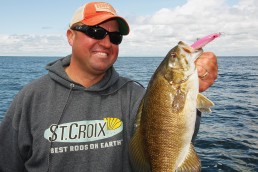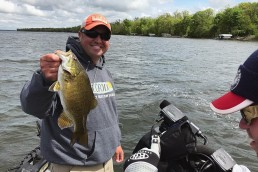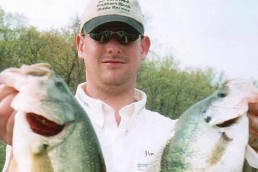Catch Summer Walleyes and Bass in Lake Mille Lacs
SHARE THIS POST
MidWest Outdoors contributor and noted fishing guide Tony Roach shares his secrets for catching walleyes and bass on Minnesota’s Lake Mille Lacs. Roach guides on this vast central Minnesota fishery in all seasons.
MidWest Outdoors: Tony, let’s focus on walleyes first. Talk about the peak live-bait bite typically going on at the end of the midsummer period.
Tony Roach: Mille Lacs walleyes start putting on the summer feedbag when the bug hatches get going, usually in late May. For the first part of the season, the fish really congregate on structure. I’m talking about the deep structure in the lake like mudflats and deep gravel bars. The 26- to 30-foot transition areas—where rock or gravel meets the mud basin—are good spots. Sure, there’s a shallow rock bite on the reefs during low light or when it’s windy, but most days you’ll want to focus on the deep structure to catch fish. The bug hatches that emerge from the mud and deep gravel bars really attract the fish in big numbers. These hatches also pull a lot of the fish in from the shallows where they’ve been feeding since post-spawn.
MWO: Talk about live-bait rigging tactics.
Roach: Live-bait rigs are perfect when the fish are bunched up on structure. You’ll see schools of walleyes on the edges of the mudflats or pods of fish as you cruise over the deep gravel. I like to use a tall bottom bouncer for my weight and run a very long leader, at least 8 to 10 feet long. (Due to excellent water clarity and wary walleyes, Lake Mille Lacs is considered one of the original fisheries where live-bait snells extended beyond standard 2- to 6-foot lengths. Some anglers employ snell lengths of 12 feet or more). Bait up with either a leech or nightcrawler and work through the fish at a slow speed, around .5 mph. As long as you have your speed right, use fresh bait and play the wind correctly with boat control, you’ll catch fish.
MWO: What are some more of your tips?
Roach: I almost always start on the upwind side of the structure, whether I’m marking fish there as well as the downwind side. When scouting with your electronics before wetting a line, never assume the fish are always on the edges of the structure, especially on those mudflats. There is a distinct edge to focus on, but always scout the tops of the flats as well as the edges. I’ll drive all over the flat and pay close attention to the depth where I’m seeing the most fish. That’s one of the nice things about Mille Lacs mudflats—if you’re catching fish at a particular depth, that’s almost always the depth you can target anywhere on that flat or even other flats and consistently catch walleyes. It makes the fish catching easier.
MWO: Slow-trolling with spinner/’crawler combos is another favorite Lake Mille Lacs tactic. What signposts lead you to choosing spinners versus live-bait rigs?
Roach: Spinner rigs are a great choice when the wind dies and you’re fishing those schools on the mudflats or gravel bars. As soon as you’re passing through fish and they stop biting the live-bait rig, that’s a telltale sign to switch to spinners. With spinners, you increase your speed to trigger bites and add a lot more action to the bait than when just using a leech or ’crawler swimming on a live-bait hook. This happens a lot in July, especially early in the month where you see those schools of fish that won’t bite a rig. I drop a bottom bouncer with a spinner and increase my speed to 1 to 1.2 mph and keep catching those same fish. Also, there are times when the wind dies and those pods of fish break up and scatter on the mudflat or across those deep gravel bars. Spinners allow you to cover more water with a live-bait presentation and trigger those walleyes to bite. There’s an old saying, “When the wind blows the gravel goes,” and that’s certainly a true statement. But even on glass-calm days you can still catch walleyes on deep gravel if you troll with spinners.
MWO: Talk about how you’re rigged up with spinners.
Roach: Mille Lacs is a pretty clear body of water. With that in mind, I usually stick with the more natural colors: gold or hammered gold, silver or hammered silver and some green patterns. For beads, mostly red, green and chartreuse are my choices. Use Colorado blades. Number 3 sizes are pretty standard, but that’s not to say we don’t experiment with bigger or smaller blades. We typically don’t use the big Great Lakes blades like you might see on Lake Erie—the Mille Lacs bite is a bit more of a finesse style of fishing. I use TroKar hooks tipped with half a nightcrawler. I like that spinning or rotating action along with the flash of the blade because I think it triggers more strikes.
MWO: In early July there’s a distinct change in the fishing patterns that anglers need to be aware of—adjusting angling tactics to stay on fish. Describe what happens.
Roach: Once the big mayfly hatches are done around the first week of July, the walleyes transition from being concentrated on that deep structure to really scattering throughout the lake, especially across the main- lake basin and around the mudflats. That’s when I deploy the crankbaits and troll with leadcore line, covering water “off structure.” That last big Hexagenia limbata hatch usually happens in early July. When the fish run out of bugs to eat they start to roam a lot more, and trolling crankbaits is the way to catch those walleyes consistently. It can be a free-for-all on live bait around that last hatch, but I’ve literally seen it happen overnight where you’re catching fish with bait one day and the next day that bite is gone. You can see it on your graph—fish stacked up on structure one day, and we get a big blow and that hatch is done and the walleyes just vanish from that structure.
Are you enjoying this post?
You can be among the first to get the latest info on where to go, what to use and how to use it!
MWO: Where should anglers focus their efforts to stay on fish?
Roach: I generally start trolling around that same structure where I’ve been fishing with live bait: close to the mudflats, over the tops of the flats or over those gravel bars. However, as we get later into this month and into August that can rapidly shift to trolling in “no man’s land” over the featureless basin. This coincides with the warmest water temperatures of the summer along with a few small insect hatches in the basin that draws ciscoes, shiners and perch into these areas. The walleyes follow them.
MWO: Leadcore is a great way to catch these walleyes for a lot of reasons. Tell us why.
Roach: Obviously, number one is you can cover the most water. We troll leadcore at 1.8 to 2.2 mph and I will vary the “colors” of leadcore. I let out between two-and-a-half and four colors. (Note: leadcore line is weighted to pull lures to the right depths without requiring sinkers or snap-on weights. Leadcore is segmented into 10-yard colors—30 feet—and the number of colors let out determines the depth to fish, in tandem with the dive curve of the lure that’s attached). Because Mille Lacs is clear, I use very long monofilament leaders, much longer than what anglers might use on other Midwestern lakes. I like monofilament because it stretches so much (up to 20 percent), making it more forgiving along with leadcore, which has no stretch. I use 10-pound-test mono and 20-30 foot leaders. On other lakes where I troll leadcore, I might only use a 6-foot leader. So, that gives you an idea of how clear Lake Mille Lacs is and how sensitive I am to being stealthy with my presentation.
MWO: Review your lure selection.
Roach: In July and August, the main forage for walleyes is young-of-the-year perch, small ciscoes and various lake shiners. To mimic that prey, I use small lures like number 5 and 7 Shad Raps. Leadcore offers another advantage because I can troll these small lures at whatever depth I want very easily. All I need to do is let out enough colors to get the lure down there to catch fish. The number 5 Shad Dancer was a hot lure for me last summer. These smaller baits are ideal in July and into August. But then I’ll start trolling some larger profiles later in the season to imitate larger prey that the walleyes are eating.
MWO: Give us some more secret tidbits you’ve learned about the Mille Lacs trolling bite.
Roach: It’s interesting how colors and lure selection can vary from one section of the lake to another. Some areas of the lake the perch-colored or firetiger lures tend to work best. Then you troll other areas of the lake and the best colors are completely different. For example, when I’m trolling the south and east sections of this lake, I almost always catch more fish on crayfish colors and some of those perch patterns. This is the part of the lake dominated by rock structure. Crayfish live here. When I troll near the north end where all the sand is, for whatever reason a lot of blues tend to work best. Then, when I troll the basin, I tend to troll a lot of blue, black/chrome, purples, those purple glass shads, and so forth. In the basin I’ll usually troll larger lures than when I’m closer to structure.
MWO: An occasional visitor to Mille Lacs wouldn’t necessarily be able to spot these trends.
Roach: Isn’t it crazy? A few years ago, the bite was hot on bigger-profile lures. Last year, it cycled back to small sizes throughout the lake. When you throw that variable out there along with color selection, it shows you why we are always experimenting with colors and sizes and different lures when trolling. If a lure is down for a while and is not catching fish, I’m tying on something new.
MWO: It probably has something to do with average forage size.
Roach: Exactly. One of my secret weapons is the Storm Smash Shad—hot lure in their Perch colors and the UVs like Blue Pink Fire. That number 5 size perfectly matches small perch in the lake. In Minnesota, we are limited to one line per angler in the open-water season. But thankfully, I have a couple of guide customers usually in the boat with me so I can run multiple lines. I almost always choose a Scatter Rap for at least one of my lines. I really like the Scatter Rap Tail Dancers and the Scatter Rap series of lures in general. I’m a big believer in its erratic action as a triggering mechanism. You don’t have to add any action to the lure on a steady troll. You know how fish will hit a crankbait on an S-turn or when you pump the rod—that’s usually because they’re following the bait for a while and not committing. But that change in cadence triggers them. Scatter Raps already dart erratically from side to side from time to time, and that’s the trigger. They do the work for you. It’s amazing how day to day and even hour to hour how much the walleyes can change from wanting one bait to another. You can move just three or four miles and the fish will want something completely different. Keep that in mind and change lures frequently.
MWO: These days, folks are referring to the lake as “The Fantastic Four” of gamefishing: walleyes, smallmouth bass, muskies and northern pike. We know what a smallmouth bass mecca Lake Mille Lacs has become with the Bassmaster Angler of the Year Championship hosted here in consecutive Septembers. Provide us with tips on catching smallies in July.
Roach: You can have an incredible topwater bite on shallow structure and even over deeper water as long as those bug hatches are still going on. Hair jigs work well then, too. Drop-shots come into play as the bass pull deeper in warmer water and stage on the deep edges of rocks around that 9- to 12-foot range. The bite on tubes is really good also. You can catch Mille Lacs bass a lot of different ways in summer.
MWO
SHARE THIS POST
Did you enjoy this post?
You can be among the first to get the latest info on where to go, what to use and how to use it!



